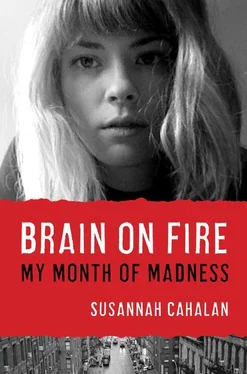But when he had trouble opening up the disk, he asked me for help. I got it to work and in the process caught a fleeting glimpse of myself in the hospital gown. I was outrageously skinny. Crazed. Angry. Reaching out aggressively toward the camera.
I shuddered and turned away from the image, trying to concentrate on breathing as I forced a smile. I had the intense urge to grab the videos from him and burn them or at least hide them away, safe from view. Even after everything I’d done and learned, maybe I wasn’t ready for this yet. Yet I felt compelled to keep watching.
I had enough distance from my own madness to view it as a hypothetical. But watching myself on screen, up close and personal, obliterated that journalistic distance. The girl in the video is a reminder about how fragile our hold on sanity and health is and how much we are at the utter whim of our Brutus bodies, which will inevitably, one day, turn on us for good. I am a prisoner, as we all are. And with that realization comes an aching sense of vulnerability.
That night I went home and passed a night of fitful dreams that blurred together. In one, I was with my mom and Allen in Summit.
“Remember when you were in the hospital,” my mom said, laughing really hard. “You were so crazy that…”
She was laughing so hard that she couldn’t complete the sentence.
“What happened?” I asked, grabbing a notebook and a tape recorder. She was laughing, gulping in air, too hysterical to talk, still laughing.
There was a second dream that blurred together with this first one. In it, I was on the epilepsy floor, but I was completely naked and in search of a bathroom to hide in. I heard a group of nurses walk by and tried to hide, but as I turned the corner, all of a sudden I saw Adeline, the Filipino nurse from the floor. Now I was fully clothed.
“Susannah,” she said. “I hear you’re not taking care of yourself. What a shame.”
Though I hesitate to draw any Freudian meanings from these dreams, they clearly represent the anxiety I felt about how I behaved in the hospital and how others perceived me during my recovery. This was not where I wanted to be psychologically as I started working on my first major assignment back at the Post. I didn’t want to be frazzled and upset, and these tapes had obviously upset my internal balance.
But, ready or not, on Sunday, October 4, the biggest story of my career ran in the Post under the headline: “My Mysterious Lost Month of Madness: I was a happy 24-year-old suddenly stricken by paranoia and seizures. Was I going crazy?”
CHAPTER 48
SURVIVOR’S GUILT
It is one thing to research your own condition and think abstractly about the other people who have suffered from the same condition; it’s another thing entirely to get to know the people themselves who have run the risk of being lost in the system.
Because I had been the only person ever to be diagnosed with anti-NMDA-receptor autoimmune encephalitis at NYU, I had felt as if I was in a rarified group of the walking wounded without any compatriots with whom to share war stories. I was wrong.
Although anti-NMDA-receptor autoimmune encephalitis is rare, it is one of the more than one hundred different kinds of autoimmune diseases that afflict an estimated 50 million people in the United States, a staggering figure that has more than tripled in the past three decades. 58An alarming majority of autoimmune diseases—around 75 percent—occur in women, affecting us more than all types of cancer combined. Autoimmune diseases are most likely the number one cause of disability in women of all ages. There are multiple theories about why women are so disproportionally affected, ranging from genetic, to environmental, to hormonal (most women are of childbearing age when they are diagnosed), to the fact that women’s immune systems are more complicated (they need to identify and safeguard fetuses, which are half-foreign entities, during pregnancy), and with everything more complex, malfunctions are all the more severe. For now, it’s just one more riddle in a series of question marks.
Dr. Dalmau and his lab have also identified other receptor-seeking autoimmune diseases that occur in the brain, making the anti-NMDA-receptor variety still rare but not unique. Now antibody-mediated autoimmune diseases have become a bonafide group of syndromes. Dr. Dalmau’s lab has identified six other types of antibodies that target various receptors in the brain, adding to the NMDA-receptor-preying kind, which struck me. This figure is growing. Dr. Dalmau estimates that when all is said and done, there could be twenty or more. These discoveries finally will give names to diseases vaguely referred to as “encephalitis of an unknown origin,” or “psychosis not otherwise specified,” or not given any designation at all.

So it was no wonder that after the Post article ran, my inbox filled with hundreds of e-mails from mothers and fathers whose children had recently been diagnosed with all kinds of autoimmune diseases, women my age in the throes of the same disease, and people who suspected that their loved ones had it and wanted information on how best to treat it. Like any other major trauma, this disease bursts you wide open, and after surviving so much, you’re finally prepared to give back and willing to help anyone else who may be going through similar upheavals. But being so exposed, like a gushing wound, leaves you unprotected from the elements.
Many of the stories that I heard from that time were similar to my own, if not more harrowing. The words of people I spoke with kept me up at night: Why me? Why did my antibodies decide to attack? Why was I able to then recover?
I live with that constant refrain—not of self-pity but the real question of why my body decided to turn on itself. Then again, why does this happen to anyone? There are now thousands of cases of anti-NMDA receptor autoimmune encephalitis and many that have not ended well: an elderly woman who passed away because she had been misdiagnosed with a urinary tract infection; a woman who was pregnant when her symptoms progressed had lost her baby; several girls who had their ovaries removed when the doctors could not find a teratoma and the immune suppressants that had worked wonders on me didn’t help them.
Almost everyone I spoke to had experienced delusions and hallucinations: a music teacher saw and heard a full symphony outside her window; a young woman called out for a priest, requesting an exorcism because she was certain she was inhabited by the devil; another woman my age hated herself so much during her recovery that she ripped out her hair and cut her arms. Paranoia, especially about the men in their lives, was also a common thread. A middle-aged woman believed that her husband had fathered a baby with a neighbor; a young teenager was convinced that her dad was cheating on her mother. One twelve-year-old I spoke to tried to jump out of a moving car; another woman had an obsession with grapes (like my fixation on apples).
All the people I spoke to had lost themselves. And not everyone had found herself again. Some would never be as smart or funny or animated as before the illness.
There were even calls from people who had been diagnosed with schizophrenia and were desperate for any other answer. My story gave them hope, but some of these people scared me with their persistent paranoid phone calls.
“You know they’re listening to us,” one older woman said.
“I’m sorry?”
“They’re bugging my line. So I can’t say much.”
Читать дальше













